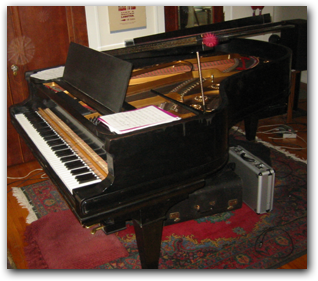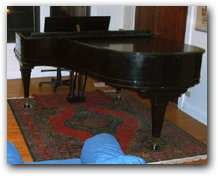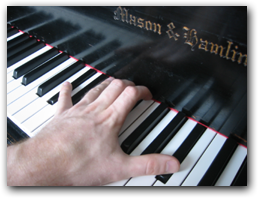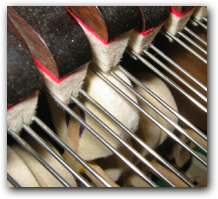
| innig.netMusicIn the HandsRecording MethodInstrument |
The first, longest, and most demanding step in making a recording is, of course, coming up with music to record. I'm not a good sight reader, and don't learn music quickly. I compose even more slowly (usually 50-100 hours of work for one minute of music, by my best guess). Mercifully, I'm not going to cover that process here. We join our hero with a piece prepared and ready to record.
If this is supposed to be about recording, why a whole page on the instrument? Well, if you ask a recording engineer how to get a great recording, they'll tell you, “start with a great instrument in a great room” — that's a lot of what makes recordings sound the way they do.
I actually only have half of that. My living room, while it is a lovely room for living, is a poor one for recording: it has mediocre acoustics, and all sorts of noises leak in from the outside. I mitigate these problems with close miking, and further correct for them in mixing and mastering.

So the room isn't ideal. The instrument, however, really is great. It's a 1929 Mason & Hamlin BB, rebuilt in 2003 with new strings and action but the original soundboard. For those of you who don't know the brand, Mason & Hamlin was Steinway's chief competitor from about 1900 until the depression. The pianos they made in this period are treasures; there's nothing like them. In 1932, under questionable management and severe financial difficulties, the original factory shut down, and the brand name has since repeatedly been sold and applied to many different pianos of widely varying quality. Apparently, in the late 90s, under yet another new owner, the company starting making really fantastic pianos again. I can't vouch for this myself, but I certainly can vouch for the work they were doing the late 20s!

It has an incredibly warm, singing sound — not the bright and brittle sound that seems to be popular these days, which I find dimensionless and unpleasant. (Most Yamahas drive me crazy.) It also has something that's unlike any other piano I've played: a sort of sparkling quality that extends from the upper treble well into the tenor.
You might notice how rough the finish on the piano is. Savvy piano buyer's tip: if you're making recordings, it doesn't matter how it looks. I saved many thousands of dollars buying the piano rebuilt but not refinished, and although it's rough on the outside, the inside is glorious.


You may also have noticed in the photo above that I play with the fallboard out. (That's the piece that sits in back of the keys, the part that you can close over them when not playing.) The reason for this is that I started developing tension problems in the muscles that extend the middle fingers on both hands. I found that the primary source of the problem was my long fingers running up against the fallboard.
Compare the two photos on the right. In a long stretch, especially with black keys on both ends, my poor fingers are in a terribly awkward position. With the fallboard out, they can extend naturally. It turns out that old pianos have very slightly shorter keys — about 0.5cm shorter — and it was just enough to turn what had always been a lurking issue into an injury. The fellow who rebuilt the piano graciously cut some slots in the fallboard, so now I can just lift it in and out. (Many modern pianos are built this way.)
With the fallboard out, I'm faring much better, thanks! It did take a while to get used to playing with the action sitting right there in front of me — sort of like driving with the hood off! — but was well worth it.
Making recordings? Tune the piano. Often. Recordings show up sour tuning like nobody's business, and it's all but impossible to fix or mask once it's in a recording. I have mine tuned about every 8 weeks, and although it helps a lot that I'm fastidious about controlling the humidity in my apartment, it's still not enough — sour notes show in many of my recordings. If I could afford to tune weekly, I'd do it.
This is a topic that could — has, in fact — filled volumes, but there are two particular details of piano regulation that contribute a great deal to the sound of my recordings.
The first is voicing. Many people like (and piano technicians will often thus presume you want) hard, bright-sounding hammers. It's acoustic poison. If you're going to be recording, especially with the close-mic technique I'm about to describe, you want your hammers soft and supple. That goes for the whole range of the piano: some technicians voice up the bass to make it automatically louder (as if one never played pianissimo in the bottom octave), or the treble to make it sound brilliant. Talk them out of it. If it sounds a little harsh in real life, it will be unbearably harsh in the recording.

The second is let-off, the distance between the hammer and the string at the point that the hammer disengages from the action and flies free. You want this to be close, but if it gets too close, the hammer doesn't quite get disengaged at all, but instead is forced up against the string (“blocking”), with unpleasant results. Good technicians thus leave a healthy safety margin.
However, my technician, bless her heart, taught me to regulate the let-off myself. This lets me keep it much closer: if it gets out of whack, I can fix it immediately myself, so less safety margin is necessary.
The result of this in the recording is that it allows extreme pianissimo, and puts some extra power behind the sound without the harshness that hard hammers bring.

The date at right, printed inside the piano, is my birthday. I mean, not in 1917, but…you know. Is that cool or what? (Hint: “what” is not the correct answer.)